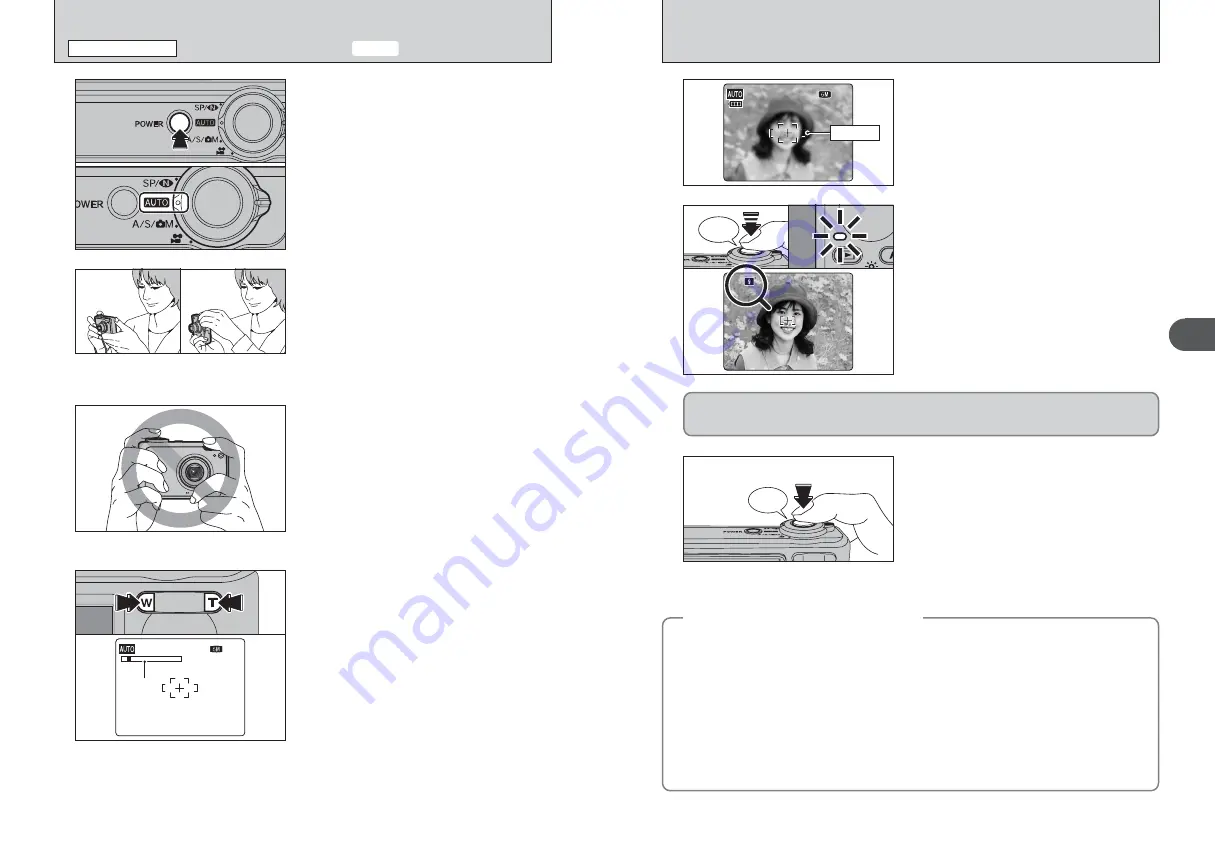
23
Using
the
Camera
2
22
Bebeep
●
!
The image shown on the LCD monitor before the picture is
taken may differ in brightness, color, etc. from the image
actually recorded. Play back the recorded image to check it
(
➡
P.27).
Use the LCD monitor to frame the shot so that the
subject fills the entire AF (Autofocus) frame.
5
Press the shutter button down halfway. When a
short double-beep is heard, the camera focuses on
your subject. The AF frame on the LCD monitor
becomes smaller and the camera sets the shutter
speed and aperture. The indicator lamp (green)
changes from blinking to lit.
●
!
When a short double-beep is not heard and “
{
” appears on
the LCD monitor, the camera cannot focus.
●
!
Pressing the shutter button down halfway freezes the image
on the LCD monitor briefly. This image is not the recorded
image.
●
!
When “
{
” appears on the LCD monitor (the shooting
condition is too dark to focus on the subjects etc.), press
again the shutter button down halfway or try standing about
2 m (6.6 ft.) from your subject to take the picture.
6
Before the flash fires, “
∑
” appears on the LCD monitor. When selecting a slow shutter speed that
will cause camera shake, “
|
” appears on the LCD monitor. Use the flash to take pictures.
According to the scene or mode being shot, use a tripod.
NNN
10
10
10
10
250
250
250
F5.6
F5.6
F5.6
AF frame
Press the shutter button down fully. When a
clicking sound is heard, the camera records the
image.
●
!
There is a slight delay between the shutter button being
pressed and the picture being taken. Play back the shot to
check the image.
●
!
When pressing the shutter button down fully in one motion,
the camera takes the picture without the AF frame changing.
●
!
When taking a picture using the flash, the image may
disappear and go dark briefly due to flash charging. The
indicator lamp blinks orange during charging.
●
!
See P.116-117 for information on the warning displays.
7
Click
◆
Subjects not suitable for autofocus
◆
FinePix F11 uses a high-precision autofocusing mechanism. However, it may have difficulty focusing
on the following:
h
Very shiny subjects such as a mirror or car
body
h
Subjects photographed through glass
h
Subjects that do not reflect well, such as hair
or fur
h
Subjects with no substance, such as smoke or
flames
h
Dark subjects
h
Fast moving subjects
h
Subjects with little or no contrast between the
subject and the background (such as white
walls or subjects dressed in the same color as
the background)
h
Shots where another high-contrast object (not
the subject) is close to the AF frame and is
either closer or further away than your subject
(such as a shot of someone against a
background with strongly contrasting
elements)
For such subjects use AF/AE lock (
➡
P.25).
1
0
1
0
2
1
Press the “POWER” button to turn the camera
on.
2
Set the Mode switch to “
B
”.
h
Focal range
Approx. 60 cm (2.0 ft.) to infinity
2
Brace your elbows against your sides and hold the
camera with both hands. Position your right thumb
so that it is handy for using the zoom.
●
!
Moving the camera while shooting gives a blurred picture
(camera shake). Use a tripod to prevent camera shake,
particularly for shots in the dark when the selected flash
mode is Suppressed flash.
●
!
There may be some uneven brightness at the lower edge of
the LCD monitor. This is normal and does not affect the
photographed image.
3
Hold the camera so that your fingers or the strap do
not cover the lens, flash and AF-assist illuminator.
If the lens, flash or AF-assist illuminator is obscured
by your fingers or the strap, subjects may be out of
focus or the brightness (exposure) of your shot may
be incorrect.
●
!
Check that the lens is clean. If it is dirty, clean the lens as
informed on P.113.
●
!
If the flash is used in dusty conditions or when it is snowing,
white dots may appear in the image due to flash reflecting off
the dust particles or snowflakes. Use Suppressed flash mode
(
➡
P.46) to fix the problem.
4
Press “
T
” (telephoto) button to zoom in. Press “
W
”
(wide-angle) button to zoom out. A zoom bar
appears on the LCD monitor.
h
Optical zoom focal length
(35 mm camera equivalent)
Approx. 36 mm to 108 mm
(
„
: Approx. 37 mm to 111 mm)
Max. zoom scale: 3
×
●
!
See P.90 for information on procedures for using Digital
zoom.
Zoom bar
Zoom bar
Zoom bar
NNN
10
10
10
10
●
!
Use Macro mode for subjects closer than 60 cm (2.0 ft.)
(
➡
P.44).
●
!
When [CARD ERROR], [CARD NOT INITIALIZED], [CARD
FULL] or [NO CARD] appears, see P.116.
TAKING PICTURES (
B
AUTO MODE)
PHOTOGRAPHY MODE
Содержание FinePix F11
Страница 66: ...130 Memo...



























